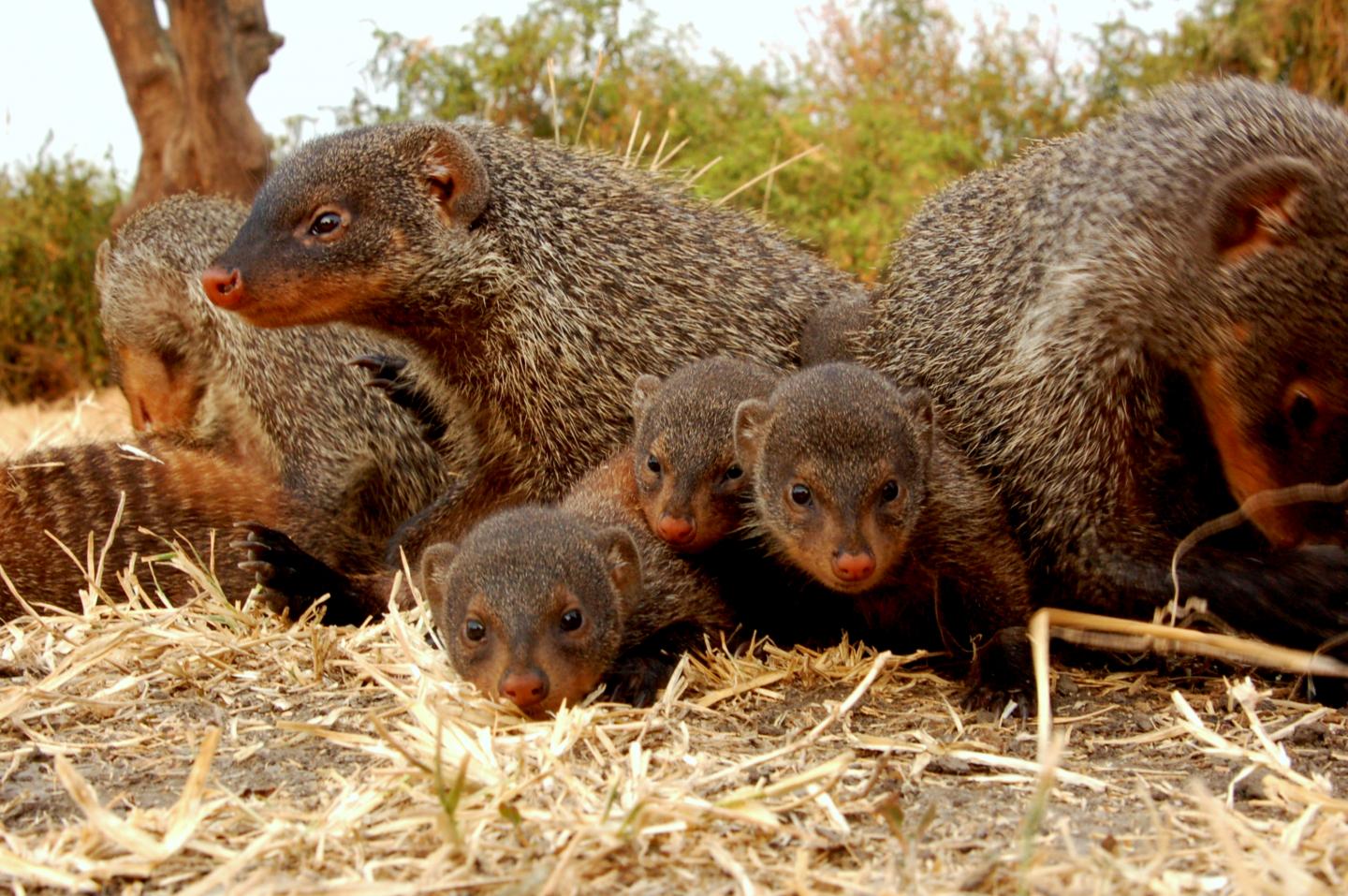|
|
High stress in pregnancy may decrease baby's survival
Pups born to female mongooses experiencing elevated stress, are much less likely to survive. Researchers studying banded mongooses in Uganda discovered that pups born to females experiencing elevated stress during late stages in pregnancy, were less likely to survive their first month.
Dr Jennifer Sanderson, now a science teacher at Bedminster Down School in Bristol, spent four years observing wild banded mongooses to understand the effects that maternal stress can have on the survival of mongoose pups.
She discovered that female mongooses at the bottom of their social hierarchy, experience increased circulating stress hormones, or 'glucocorticoids.' These high stress levels decreased the likelihood their pups survive birth. The work is published in the Royal Society journal Biology Letters.
Female mongooses have to compete to breed successfully — even in this most cooperative animal society. Such female competition in animals is widespread, but this study is the first to investigate if a link exists between socially induced stress and offspring survival in wild, cooperative mammals.
"We all think of stress as a bad thing and it's easy to imagine that high stress levels during pregnancy can have negative effects on a baby's development. Our study has shown that pups born to females with high circulating glucocorticoids in the third trimester are much less likely to survive the first weeks of life."
Jennifer Sanderson PhD, science teacher, Bedminster Down School, Bristol, United Kingdom
Banded mongooses are close relative of the famous meerkat. They live in stable social groups across Central and Eastern Africa and are highly social. They breed communally, with all females within a group commonly giving birth on exactly the same day.
However, in social species such as banded mongooses, dominant females may use aggressive tactics to induce a hormonal response in subordinates and prevent them from breeding. While previous studies had shown a link between socially-induced stress and conception rates, this is the first study to document elevated stress levels during pregnancy with loss in pup survival.
"Banded mongooses are unique as most females within the group commonly become pregnant together and give birth on exactly the same day.
At first glance it seems that the females are working together to produce and care for a huge communal litter. However, our results suggest dominant females may be stressing out other females during pregnancy - a strategy that decreases the survival chances for pups born to stressed competitors — which can increase their own pups' survival chances."
Michael Cant PhD, Centre for Ecology and Conservation, University of Exeter, Penryn Campus, Cornwall, United Kingdom.
Dr Sanderson used ultrasound to count the number of fetuses carried by banded Uganda mongooses, and used genetic analysis to find out which females were the mothers of surviving pups. She also collected hundreds of fecal samples for analysis of female hormone concentration.
The findings provide new insight into the subtlety of female competition within even the most cooperative animal societies. This helps us understand how stress in a subordinate female can affect the development of her offspring.
Abstract
Dominant females in social species have been hypothesized to reduce the reproductive success of their subordinates by inducing elevated circulating glucocorticoid (GC) concentrations. However, this ‘stress-related suppression' hypothesis has received little support in cooperatively breeding species, despite evident reproductive skews among females. We tested this hypothesis in the banded mongoose (Mungos mungo), a cooperative mammal in which multiple females conceive and carry to term in each communal breeding attempt. As predicted, lower ranked females had lower reproductive success, even among females that carried to term. While there were no rank-related differences in faecal glucocorticoid (fGC) concentrations prior to gestation or in the first trimester, lower ranked females had significantly higher fGC concentrations than higher ranked females in the second and third trimesters. Finally, females with higher fGC concentrations during the third trimester lost a greater proportion of their gestated young prior to their emergence from the burrow. Together, our results are consistent with a role for rank-related maternal stress in generating reproductive skew among females in this cooperative breeder. While studies of reproductive skew frequently consider the possibility that rank-related stress reduces the conception rates of subordinates, our findings highlight the possibility of detrimental effects on reproductive outcomes even after pregnancies have become established.
The Banded Mongoose Research Project is led by Professor Michael Cant from the Centre for Ecology and Conservation at the University of Exeter's Penryn Campus in Cornwall. It has been observing mammals' breeding behaviour for over 20 years.
'Elevated glucocorticoid concentrations during gestation predict reduced reproductive success in subordinate female banded mongooses' by J Sanderson, HJ Nichols, HH Marshall, EIK Vitikainen, FJ Thompson, SL Walker, MA Cant, AJ Young is published in the journal Biology Letters.
This study was funded by the Natural Environoment Research Council (NERC) and European Research Council (ERC).
About the University of Exeter
The University of Exeter is a Russell Group university and in the top one percent of institutions globally. It combines world-class research with very high levels of student satisfaction. Exeter has over 19,000 students and is one of the global top 100 universities according to the Times Higher Education World University Rankings 2015-16, positioned 93rd. Exeter is also ranked 7th in The Times and The Sunday Times Good University Guide 2016, 9th in the Guardian University Guide 2016 and 10th in The Complete University Guide 2016. In the 2014 Research Excellence Framework (REF), the University ranked 16th nationally, with 98% of its research rated as being of international quality. Exeter was named The Times and The Sunday Times Sports University of the Year 2015-16, in recognition of excellence in performance, education and research. Exeter was The Sunday Times University of the Year 2012-13.
Return to top of page
|
|
|
Nov 6, 2015 Fetal Timeline Maternal Timeline News News Archive

High stress during pregnancy decreases offspring survival, according to this mongoose study.
Image Credit: Harry Marshall
|
|
| |
|



